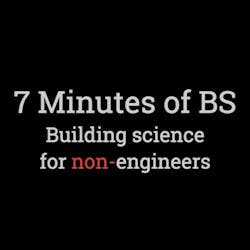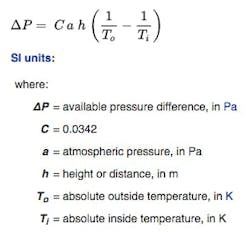Stack Effect: 7 Minutes of BS (#buildingscience)
While it is not the biggest pressure affecting houses, stack effect is incessant: as long as there is a temperature difference and some height, it is churning air. It is an important consideration in houses, and a big deal in tall buildings.
Today, Jonathan Smegal joins the show from RDH Building Science Laboratories in Waterloo, Ontario.
What stack effect is:
stack ef·fect | Stak əˈfekt | n.
The movement of air into and out of buildings, chimneys, flue gas stacks, or other containers, resulting from air buoyancy.
—Wikipedia
Also known as chimney effect. It usually occurs in tall buildings when the temperature difference between the outside and the inside is great.
—Jonathan Smegal, RDH Building Science Labs
How stack effect works:
"Warm air inside a building rises to the top and it pressurizes the top of the building—the air wants to escape at the top—and it tries to suck air in at the bottom."
Strangely, the stack effect works in reverse during summer, because the hottest air is outside the house.
"In warm weather when you air condition a building to be a lot cooler than the outside air, air tends to fall inside the building and it draws hot air in at the top as it pushes air out the bottom at the ground floor."
"Stack effect is controlled by two things, if we were going to look at the equation—which we're not—it is controlled by the height of the building and the temperature difference between inside and outside the building."
The greater the temperature difference, and the taller the building, the greater the pressure.
(That's why chimneys are so good at sucking up.)
"The pressures are greatest at the bottom and the top, and they tend to be neutral somewhere in the middle."
So the bottom tends to have high negative pressure, the top tends to have high positive pressure, and the middle is right in the sweet spot.
This is called the neutral pressure plane, in case you were interested.
Why stack effect matters:
Comfort is the number one complaint in buildings that are actively getting sacked by the stack. People in the top floors overheat, open windows, relieve pressure, which allows cold air into the bottom floors. So the people on the bottom floors turn up their thermostats because they're cold.
When the heat rises, the penthouse people open their windows and freeze the feet of the peeps at the street level.
Another implication of the stack effect is moisture damage. Because moisture rides on air currents, any part of a building experiencing a large flow of air between inside and out will find moisture deposited on cold surfaces.
You can see the results sometimes on masonry buildings, like brick buildings.
"Depending on the height of the building, the brick is often deteriorating. Most air accumulates in the brick and it can cause staining, freeze-thaw damage, the efflorescence of the brick..." But it is not confined to brick. Any time there is pressure pushing the interior air into the wall cavity you can definitely get condensation and durability-related issues."
For the record, 'durability-related issues' is engineer-speak for 'rot.'
Energy loss is another consequence of unintended pressures. Obviously, any time you're spending money to condition the air, whether you're heating it or cooling it if it escapes, it is wasted energy.
How to 'stack' the deck in your favor:
One solution to problems associated with the stack effect is to build extremely short buildings.
That works for ranch houses and ramblers, but it won't fly in cities, where there's more 'up' than 'out.'
"In taller buildings, one thing that they do is put vestibules on the elevators, because the elevator shaft is a continuous shaft that runs the entire height of the building. The vestibule keeps the elevator separated from the rest of the building. A simpler, and more elegant, solution is a revolving door, which reduces the air leakage in the foyer space."
"If you put a normal door on a tall building, you can't get it open because the pressure is so high at the bottom floor, that you can't open the door."
In a house, stack effect pressures are not as high as in taller buildings, but it can certainly cause uncomfortable drafts, moisture movement, and energy loss. Like all buildings, the top and the bottom have the highest pressure, so make sure you have a tight ceiling plane—including holes for can lights, dropped soffits, and tray ceilings.
At the bottom of the building, the biggest leaks are in the rim joist assembly because there are so many components fastened together.
"If they're not detailed correctly, in terms of connecting all the parts of the air barrier system, you'll get a fairly significant amount of leakage at the rim joist."
For Institutional applications—like hotels with swimming pools—you can fight pressure with pressure. Using the HVAC system, you can compensate for the positive pressure with a negative pressure—like a big ol' fart fan for your swimming pool!
Bonus application of stack effect:
"One of the coolest applications using stack effect that I've seen are these solar chimneys, where they make a huge solar collector on the ground and they have a really, really tall tower that's essentially just a chimney."
"They have a wind generator in there, so they heat up all this space, and because of the pressures generated by stack effect—because of the height of the chimney and the temperature difference—they can generate enough airflow to produce energy... they're talking about powering like 100,000 houses."
"When you're talking about stack effect, I think that's a really cool application of the science."
That's where Jonathan left it and that's where we're going to leave it for episode 2 of 7 Minutes of BS.
Extra credit:
- Building Science Corporation: How Do Buildings Stack Up?
- Wikipedia: Solar Wind turbine
- SolarTower.org: A possible solar tower project in Arizona
—Remember, you get paid for what you do and what you know. There are only 24 hours in a day, but the information is infinite. If you like this podcast, share it through Facebook, Twitter, LinkedIn, Snapchat, or however you reach out to your peeps.


